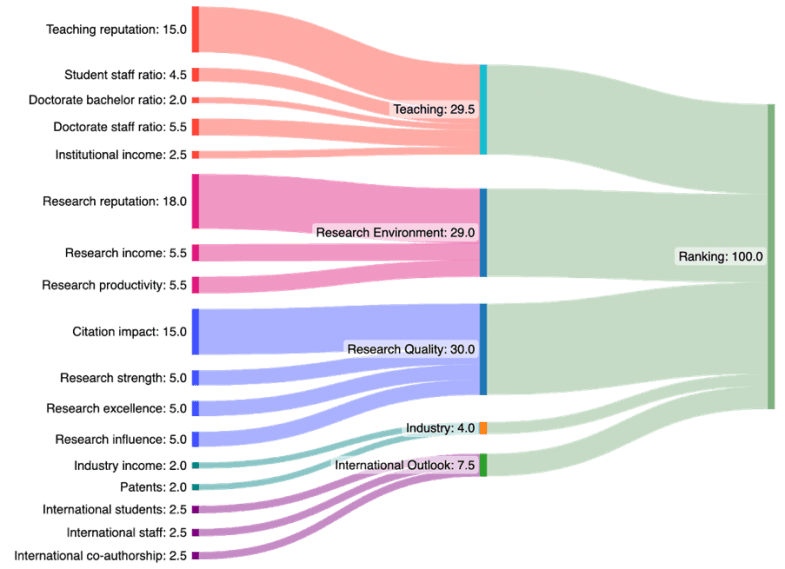What are the THE World University Rankings?
How are the results of the World University Rankings and Subject Rankings calculated? Read an explanation of the methodology and what the results mean.
Share
Before you even hit your twenties, you are faced with one of the most important decisions of your life: which university to choose.
The decision will, for better or worse, affect your social life, finances and career for years to come.
For 20 years, the Times Higher Education World University Rankings have been providing young people and their families with trusted guidance to help with this decision.
The rankings grow and adapt every single year to include more countries and more universities.
This enables you to evaluate a greater range of institutions, whether you are looking to study abroad or domestically.
Each university is judged in five categories covering the core missions of all world-class, global universities: Teaching (the learning environment); Research environment (volume, income and reputation); Research quality (citation impact, research strength, research excellence and research influence); International outlook (staff, students and research); and Industry (income and patents).
The World University Rankings table allows students to browse universities by overall rank, as well as by country. The table can also be filtered by scores in each category, allowing to see which universities rank the highest for teaching environment or research.
We also collect data on “key statistics” for each university: the number of students, the student gender ratio, the staff-to-student ratio, and the percentage of international students.
The full methodology can be found here.

Teaching: the learning environment
For any student studying any subject, the most important factor is the teaching environment: what it is like to learn at the university.
The Teaching metric is measured by five performance indicators: teaching reputation, staff-to-student ratio, doctorate-to-bachelors-ratio, doctorates-awarded-to-academic-staff ratio and institutional income.
These give a good indication of the prestige, facilities and resources of the teaching environment, all of which would have a direct impact on you, the student.
This category is also underpinned by the Academic Reputation Survey which asks scholars from around the world to share which institutions they believe are excelling in teaching and learning.
Research environment
A university might excel in teaching but not in research: a good teacher does not necessarily a good researcher make. But the quality and volume of research at an institution is nonetheless relevant to you if you are seeking the best academic experience.
If you have the opportunity to learn from leading researchers, you will benefit both intellectually and practically. You will learn not just about the research they are doing, but also pick up essential skills that will benefit you in any career you choose.
At the best research institutions, you will also be able to take advantage of resources and facilities available only in such environments.
The Research metric is measured through research reputation, research income and research productivity.
Research quality
The ultimate test of the quality of research is its impact, for all research aims to be influential and important.
The research quality category looks at citation impact, research strength, research excellence and research influence.
The greater the number of citations of a university’s work, the more likely that you will engage with scholars who are leading and expanding the discussions in the field.
The last three metrics look at how research from a university is used and the volume of output each year.
International Outlook
Universities are no longer compared just with rivals in their own city, or even their own country; world-leading universities are competing globally and attracting students and researchers from across the world.
International outlook is therefore a mark of a top institution, relevant both to international and domestic students.
It is measured by three indicators: proportion of international students, proportion of international staff and international collaboration.
The benefits of an international environment on campus range from cultivating open-minded discussions with diverse opinions to improving cross-cultural relations.
But at a more basic level, an isolated institution without international connections simply cannot count itself among the world’s best universities in an increasingly global and mobile world.
Industry Income
Industry income is increasingly becoming a priority for universities and students. It indicates the commercial impact of an institution’s research, which is itself a reflection of the industrial value of the research.
The industry income indicator is of fundamental importance if you prioritise the real-world application of research and how much a university is dedicated to supporting their local and national economies.
This category is calculated by colleting data across two metrics: industry income and patents.
The Subject Rankings
In addition to the THE World University Rankings, 11 individual subject rankings allow you to delve deeper across different disciplines: Arts and Humanities; Clinical, Pre-clinical and Health; Engineering and Technology; Life Sciences; Physical Sciences; Social Sciences; Law; Psychology; Education; Computer Science and Business and Economics.
The 18 performances indicators are the same, but the weighting of each indicator is adjusted for the particular features and priorities of the discipline.